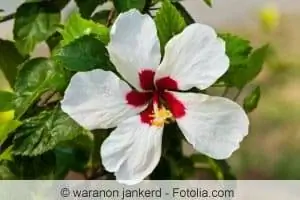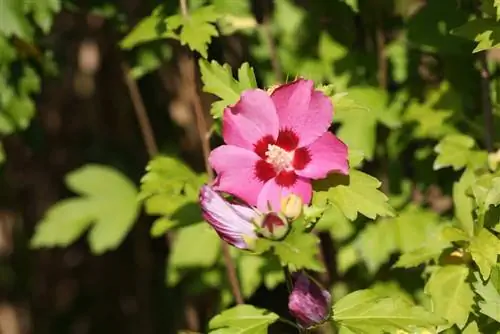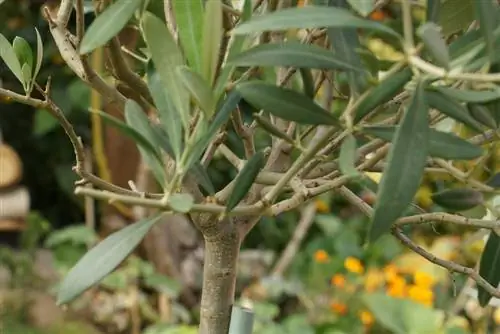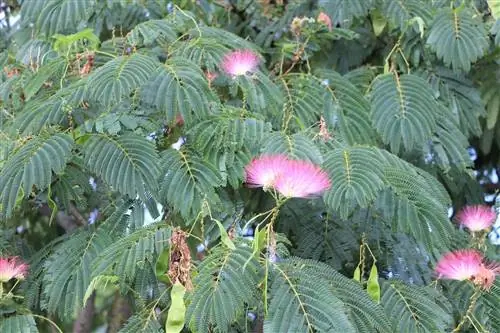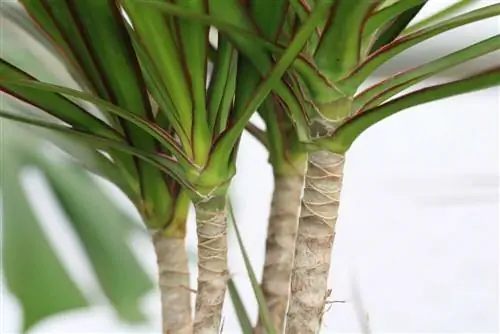- Author admin [email protected].
- Public 2023-12-17 03:39.
- Last modified 2025-01-24 12:45.
The hibiscus tree with its colorful abundance of flowers requires a skilled hand, especially during annual pruning. The garden hibiscus can be cultivated outdoors as a shrub or as a tree. Some hybrids of Hibiscus syriacus have been bred as a tree. These hardy varieties are characterized by rich flowers in different colors. With the right cut at the right time, the garden hibiscus blooms from July to September. In any case, it requires a sunny location, sufficient water from April onwards and regular fertilizer for flowering plants.
Recommended varieties
Most hardy hibiscus trees come from the relatively hardy and garden hibiscus (Hibiscus syriacus). Some species of H. Syriacus are also available as a trunk or half-stem:
- Hibiscus syriacus 'Hamabo' - trunk: A real permanent bloomer with many delicate pink flowers. It is hardy and sheds its leaves in autumn.
- Hibiscus syriacus 'Woodbridge' - trunk: A particularly undemanding, diligently flowering tree, with strong pink and red, unfilled flowers.
- Hibiscus syriacus Trio-stem hibiscus: A tree with three trunks. A winter-proof garden wonder that blooms in three colors. The unfilled flowers shine in red, purple and white until September. The trio trunk can grow up to 2 meters high.
- Hibiscus syriacus 'Red Heart' strain: Many white flowers with a purple center adorn the crown of this strain in late summer. Red Hart grows quite slowly, is frost hardy and does well in normal, loose garden soil.
- Hibiscus syriacus 'Blue Chiffon' trunk: Large, delicate purple-blue and double flowers adorn this species, grafted onto the trunk. This trunk loves it sunny and can tolerate light winter protection.
Care
April is a good time to plant your newly acquired hibiscus tree outdoors. This means it has six months to take root firmly until winter. Please note the following regarding the location and the soil:
- sunny to partially shaded place
- sheltered place
- calcareous clay soil to light, humus-rich soil
-

Hibiscus is robust, but likes it protected from the wind and at least partially shaded no acidic or compacted soils
- Use high-quality potting soil for the pot
- If possible, do not move or turn the pot over during the entire growing season
The relatively robust garden varieties do not require too much care. During the entire growing season, the garden marshmallow must never dry out completely. Too much dryness makes it susceptible to diseases and pests, especially aphids. This also greatly reduces its ability to bloom in summer. Fertilization can be carried out as early as March and April. Best with a complete fertilizer for flowering plants. From then on, the hibiscus in the pot receives fertilizer every two weeks with the irrigation water. The tree outdoors is fertilized twice, once shortly before budding, usually in April and once shortly before flowering in May, June.
Cut
Only if everything goes right when cutting, the hibiscus tree in the garden becomes a blooming wonder in summer. As with almost all trees and shrubs, a distinction is made between training pruning, maintenance pruning and rejuvenation pruning. Basically you can prune twice a year, in spring and autumn. But once a year is completely enough. For young plants, training pruning is very important so that it branches well and has an attractive shape. If you want to “transform” a young hibiscus bush into a tree, you must take special care with the annual pruning. This conversion also requires a lot of patience, because the garden hibiscus grows rather slowly. Tip: Always cut the shoots and branches diagonally and with sharp, clean tools. The slanted cut surface faces downwards for better wound healing.
Educational Cut
When you are young, you can cut back heavily. All branches are cut back to 3-4 buds. If a good main trunk is already visible, you should not prune it any further. All side shoots are cut back every year except for one eye. Only when the trunk has reached the desired height can you start designing the crown. To do this, the side branches are completely removed and the strongest branches for the crown are cut back to just a few eyes. So it can take a few years until you have formed a stately hibiscus tree yourself.
Conservation cut
The maintenance cut ensures that the hibiscus maintains its beautiful shape and blooms. The crown should be evenly rounded. Shoots that shoot out of line must be removed. Over time it may also become necessary to thin out the crown because too many branches have formed due to frequent pruning. With hibiscus, the flowers only grow on the new shoots. So every year the branches on which the marshmallow has bloomed have to be shortened by a third. Regular pruning not only means more blooms, it also results in larger blooms.
Rejuvenation cut
The rejuvenation cut only becomes important for the hibiscus stem as it gets older. Old and dead shoots are removed. Shaping and thinning cuts are also considered rejuvenating measures. A hibiscus tree that has become too large can easily be shortened by up to two thirds.
Tip:
If a hibiscus stem in the pot has become too big for you, it is best to shorten it, for practical reasons, before the pot goes into its winter quarters.
Wintering
The Hibiscus species of the Hibiscus syriacus variety are all hardy. But the stems that are outdoors can still tolerate light winter protection in the first few years. To do this, you can protect the trunk lengthwise with a fleece. The root area is best protected with brushwood, leaves or mulch. As a container plant, the garden marshmallow, like all exotic plants, can move into winter quarters. Here it should be around 10 °C cool and bright. Large and older trees can also overwinter outside in a sheltered place. To do this, wrap the bucket with insulating material. To protect the roots, place it on a Styrofoam plate.
Conclusion of the editors
The garden marshmallow or hibiscus is, despite some demands, a very robust shrub or small tree and very suitable for planting outdoors or in pots on terraces and balconies. Regular and professional pruning is rewarded with beautiful, large flowers every year. If you prefer something a little more demanding, you can grow a trunk or half-trunk from a hardy shrub variety.

Care
- A hibiscus trunk is best planted in spring because it is still somewhat sensitive to frost in the first few years.
- It grows best in a sunny and sheltered place in loose soil.
- During flowering, it should be watered during longer dry periods, otherwise it may drop its buds.
- To prevent the roots from drying out, the soil around the trunk can be covered with a layer of mulch.
pruning
- A hibiscus tree only produces its flowers on the new shoots, so it has to be cut back every year.
- All branches can be shortened except for a few eyes.
- With standard trees, however, care must be taken to ensure that the crown retains its spherical shape.
- You can wait until spring before cutting, because the hibiscus is one of the plants that doesn't sprout again until late.
- Its flowers don't last long, but new ones form almost every day from summer to autumn.
Wintering
In the gardens and on the terraces there are mainly two types of hibiscus that require very different care during the winter.
- The garden hibiscus (Hibiscus syriacus) is hardy and only needs light protection for the root area when it is young. Leaves, mulch or brushwood can be used for this.
- The rose marshmallow (Hibiscus rosa-sinensis) is sensitive to frost and should therefore overwinter in a bright room where the temperature is around 10 to 15 °C. It stays there until the outside temperatures are permanently above 10 °C again and is only watered a little during this time.
A small hibiscus tree for the terrace or front garden is usually the Hibiscus syriacus, so it can also overwinter in the garden. However, for stems in pots, the pot should be wrapped with an insulating material and kept somewhat protected. To protect the roots from the cold from below, the pot can be placed on a polystyrene plate.

